With the arrival of ever-growing numbers of cranes, geese, swans, and other late fall migrants, it’s worthwhile addressing this period when stopover flocks concentrate at traditional locations or convenient feeding areas – it’s all part of the excitement of the season that in this region is emphasized the first 12 days of November. It increases our appreciation for the assembled birds, knowing they will not stay forever, and while they are present the potential for photo ops is inspiring.
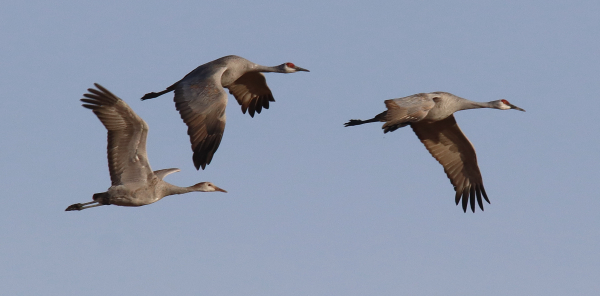
These days I’m surrounded by thousands of Arctic-nesting geese numbering 5 species total – Snows, Ross’s, White-fronted, Cackling, and Canada Geese! In addition, there are Tundra Swans and a variety of ducks, with the greatest numbers among Mallards and, surprisingly, Green-winged Teal. I would expect a level of predictability among the flocks, but they have been pretty fickle this fall when it comes to their positioning at area lakes and feeding fields. But that keeps things interesting and creates the need/desire to check on their activities periodically throughout the day, and the next day, and the next.
Over the weekend, the thousands of “local” geese were centered on 2 lakes – a mile northwest and a mile northeast – with swans in the northeast lake. Conversely, the hundreds of Sandhill Cranes I’ve been monitoring and photographing the past couple weeks are 2 hours west-northwest of here at Long Lake National Wildlife Refuge, where increasing numbers of geese and swans are building.
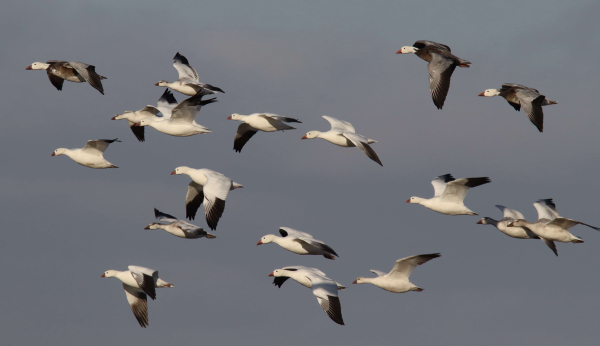
Lone raptors and other interesting birds provide periodic opportunities to zero in on their activities too. Eagles, hawks, falcons, and mini-falcons fill that bill along with a Ring-necked Pheasant or the first sightings northern songbirds – perhaps Lapland Longspurs or Snow Buntings. In short, it’s an exciting period for bird photographers, and it’s important to take advantage of the exciting opportunities before us. This past week, the first week of November, I spent a lot of extra time in the field with my camera, and want to share some of things I thought would be helpful to any birders with photographing in mind as the season changes to late fall.
Time Change
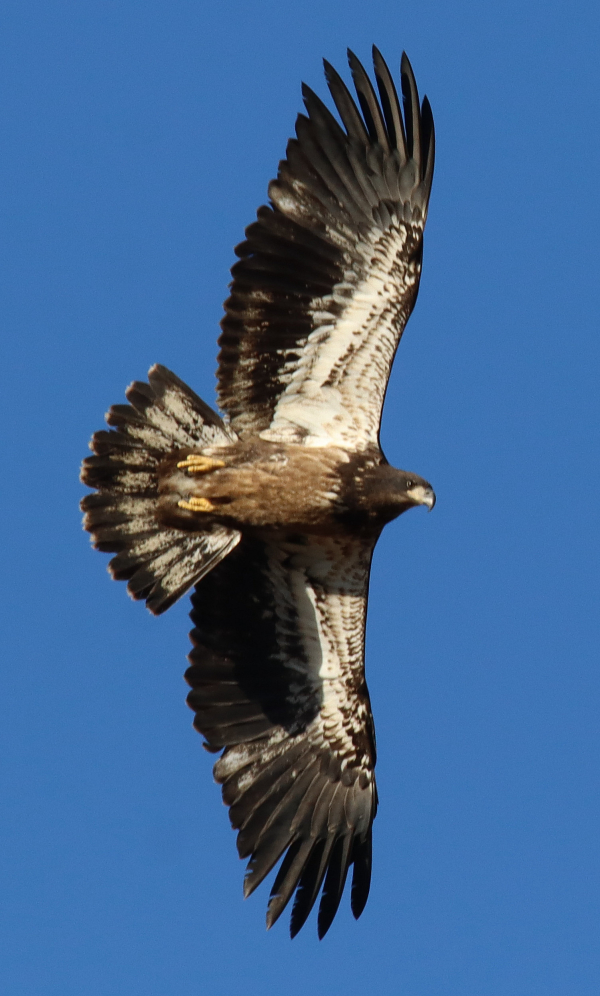
Photographed while banking at a 180-degree angle, this young Bald Eagle reveals beautiful patterns on the underside of its tail feathers and wings during a blue sky afternoon (600mm zoom lens, aperture f-9, shutter speed 1/800, ISO 400). Note how sharp the eagle is in flight using just a 1/800 shutter speed.
|
We’ve all noticed the effects of ever-shorter daylight periods the past few months, but it’s really making a big difference now. First, the sun comes up later and sets earlier; therefore, our prime photo times have changed. Second, we just set our clocks back an hour early Sunday morning, so we need to adjust to that too; and Third, at this point in the season the direction of the sunlight is predominantly from the south throughout the day – even at high noon, which may be the best change of the season for photographers.
First, at this point the prime time for photography begins about an hour after sunrise on sunny days. Sunrise is about 7am in my area, so I plan my photo sessions accordingly. Prime time ends about an hour before sunset on sunny days; and because the sun is so far south in the sky throughout the day now, even at high noon the lighting isn’t tooo harsh. If you are looking for prime time photo period, I’d say with standard time in affect now, from 8am to 11am and from 2pm to 4:30pm as prime time here.
Overall, it’s best to be aware of your shadow and where it is pointing when photographing. As long as you position yourself between the sun and the birds, with your shadow pointing toward your subject, you should have pretty good luck getting quality photos during prime times. It’s also worthwhile to watch the length of your shadow and how it changes during your photo activities. Your shadow will be longer earlier in the morning than at noon, and it will get ever longer as the afternoon leans toward sunset. By being aware of these changes in shadow length, you can plug them into the times of day when you get the best sunlight for bird photography; then, if you only have a short period of time to photograph, you can try to arrange your schedule to photograph during prime sunlight periods.
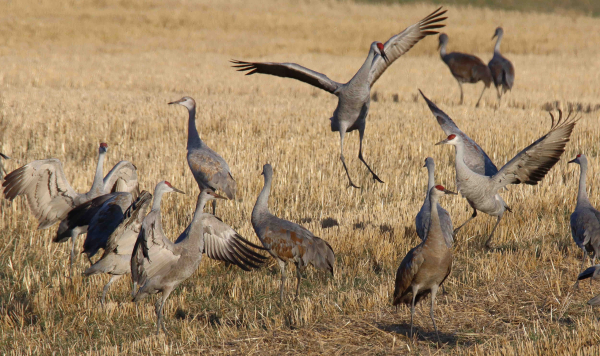
Banking on Shadows
If you are concentrating on photographing birds in flight, like I did during the past week, the best periods tend to be when the sun is lower in the sky during morning and afternoon. Why? Because sunlight tends reduce shadows that form beneath flying birds when it’s from the side rather than from a higher angle, which will tend to create more shadowing. One thing that can be helpful to avoid shadows is to be aware of them; watch for them on your subjects, and in the case of flying birds, if you can time your photos when the bird angles upward to show more of its underside, or when it banks and thereby eliminates some of the shadows.
I used this technique when photographing birds in flight this week, especially Sandhill Cranes and White-fronted Geese, watching the lighting on the birds as they flew, and more specifically watching for shadows formed during wingbeats. Then, if they tipped a bit to show some of their underside, that was a definite plus. The most extreme example of that tipping, or banking, came when I saw a Bald Eagle flying toward my position on the edge of Long Lake.
The first-fall eagle showed mostly dark brown on its dorsal side, but when it tipped to one side it showed more interesting color variations in its plumage. That’s when it went into a full 180-degree banking flight that transitioned its direct flight into a circling soaring flight. As it banked, I reacted by taking 2 quick photos that turned out quite beautifully, and I continued to photograph as it showed its backside, then reverted to another underside bank. As it turned out, that was my best opportunity for a photo that afternoon, and I share it with you here as an example.
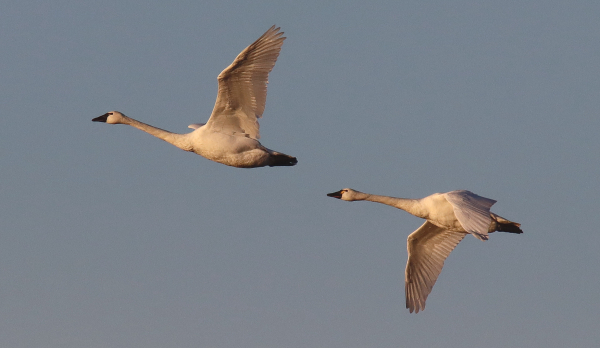
In the Moment
Once in position, with the sun at your back and the cranes, geese, swans, or eagles before you, it’s mostly a matter of following their movements and photographing them when it looks promising, in different positions. Take more photos than you may think is necessary as they fly, remembering to hold you breath as you press the shutter button. The same goes for when birds are walking, wading, feeding, or engaged in other activities – but be ready for any ensuing action.
With plenty of sunlight, I preset my camera using my Mode setting in Aperture Priority (Av), which automatically balances the aperture selected with the corresponding shutter speed. I start with an aperture setting of f-8, which provides a fairly broad area in focus. That said, if I need a faster shutter speed I dial my aperture to f-7, f-6, or f-5. Then too, if I’m trying to reduce the area of focus and effectively blur out the background, I dial the aperture to f-6 or f-5. To ensure a broader area in focus, I use an f-10, but while photographing most days this week I see I was using an f-9 aperture.
Then, while photographing large birds in flight, press lightly down on your shutter button to activate the auto-focus on one of the birds, usually the bird that is in the lead of a flock or the closest bird, and enjoy photographing the action. It all adds up to taking advantage of the sunlight, the birds, and the activities they are engaged in. We become better photographers by taking more photos, spending more time photographing, and by timing photo periods when the sunlight provides the best chances for photo success. Good luck as each week continues to bring new birds that create quality photo opportunities – it’s all part of the birding excitement of November.
Article and photographs by Paul Konrad
Share your bird photos and birding experiences at editorstbw2@gmail.com